
Travel is not necessarily as easy as it used to be. Chaos is the name of the game for many airlines, as many flights are getting canceled and even entire brands are getting shut down. Just ask WOW air. Renting a car is a pain. Train travel has yet to get back into fashion, for multiple reasons.
That’s probably why so many are flocking to recreational vehicles. Until recently, RVing was seen as more of a retiree’s sport. Many have seen the freedom to travel at will as something that can only be done when you have no work commitments.
As more people are working remotely than ever before, the need to be retired to hit the road whenever is no longer an issue. No one wants to wait that long to see things. If life has taught us anything, it’s that tomorrow isn’t guaranteed. If we want to go out and see the world, we need to do it now.
Since not everyone has the desire, or budget, to jump right into a massive Class A, there is a whole array of smaller RVs that do the trick.
Get your equipment ready to store, we’re about to hit the road!
Small RV Options
Small can be deceiving. It doesn’t necessarily always refer to short, it can also mean a lightweight RV as well. I’ll go over a variety of RV types that are used in different ways. For this list, we’ll start with the bigger of the RVs and work our way down.
1. Class B Motorhome
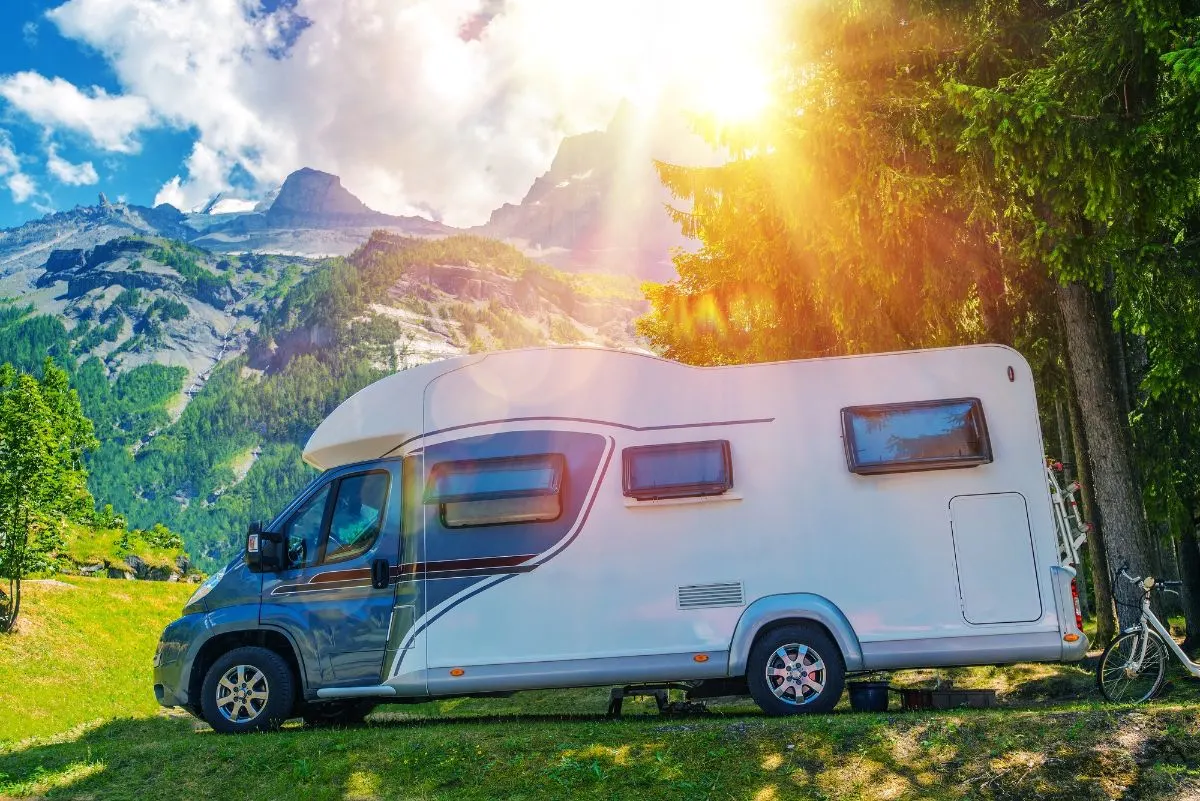
Our first on the list is the only motorized RV. Class Bs are also called campervans. The reason is that they look more like vans than what you envision for a motorhome. Ironically, Class B units are often quite expensive, considering their smaller size.
However, they have the convenience of the bigger Class A or Class C with the size of a minivan. You might be wondering why someone would choose a Class B if it’s more expensive and tiny.
The big benefit is control. Class As are intimidating to even the most seasoned drivers. It’s sort of the equivalent of driving a bus. Class B offers the driver a much more manageable vehicle to get around in and relax in at the end of the day.
Typically, a Class B sleeps two but still has room to offer a kitchen, dining room, and restroom with bathing.
2. Lightweight Trailer
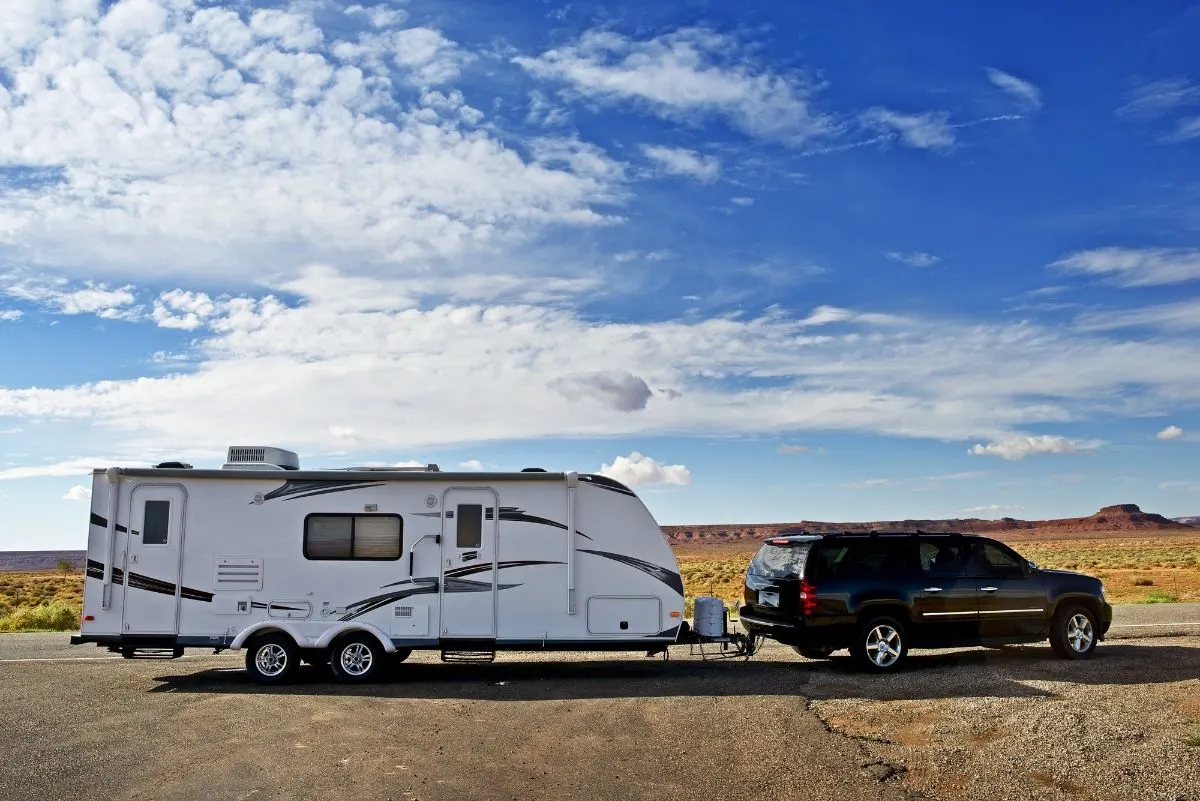
A lightweight trailer is a regular travel trailer, just with less weight. Imagine a travel trailer that a compact SUV could tow. Basically, it’s a mini travel trailer. The benefit of having a lightweight trailer is a smaller vehicle with less towability can pull it. In comparison, fifth wheels and heavier travel trailers have to be pulled by trucks and full-size SUVs.
Another positive of a lightweight trailer is storage space. Usually, underneath the floor of the trailer is storage. There’s a door on the outside that lets you make all kinds of room for your luggage, equipment, and more. These trailers can often sleep up to four and have a dining area with a kitchen, as well as a place to sit and hang out.
3. Pop-up Trailer
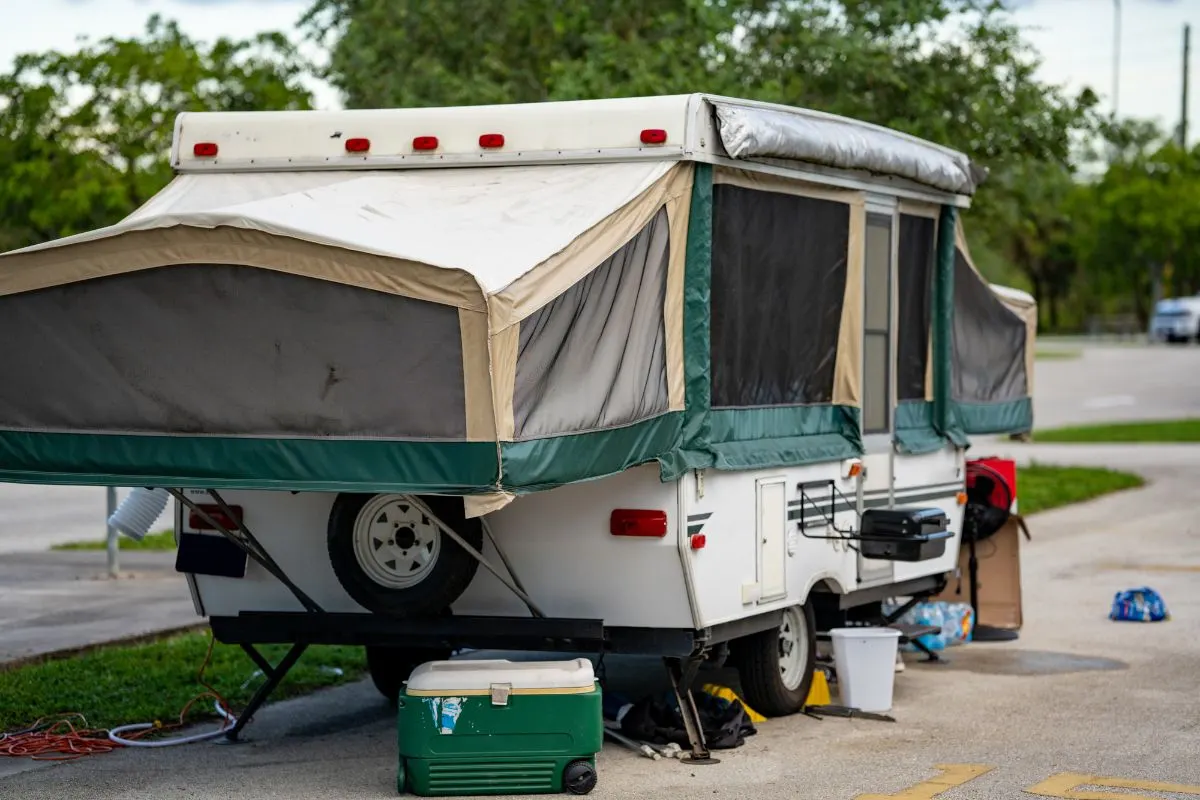
At first glance, you might not know what is being towed beside you while driving down the highway. A pop-up looks like half an RV, from the windows down. That’s the beauty of a pop-up, being able to condense is not lost on an owner of this type of RV.
When they are unlatched, the unit actually pops up. Suddenly, there’s a living space, a kitchen, and a bed! Don’t forget the windows with a view. The whole area is now enclosed with a mesh screen that keeps the bugs out and offers an enclosure.
There are quite a few variations by brands on how the interior is laid out and what amenities are offered, but they just keep getting better every year. The wood floors are static homeworthy. Pop-ups sleep up to four.
4. Teardrop Camper
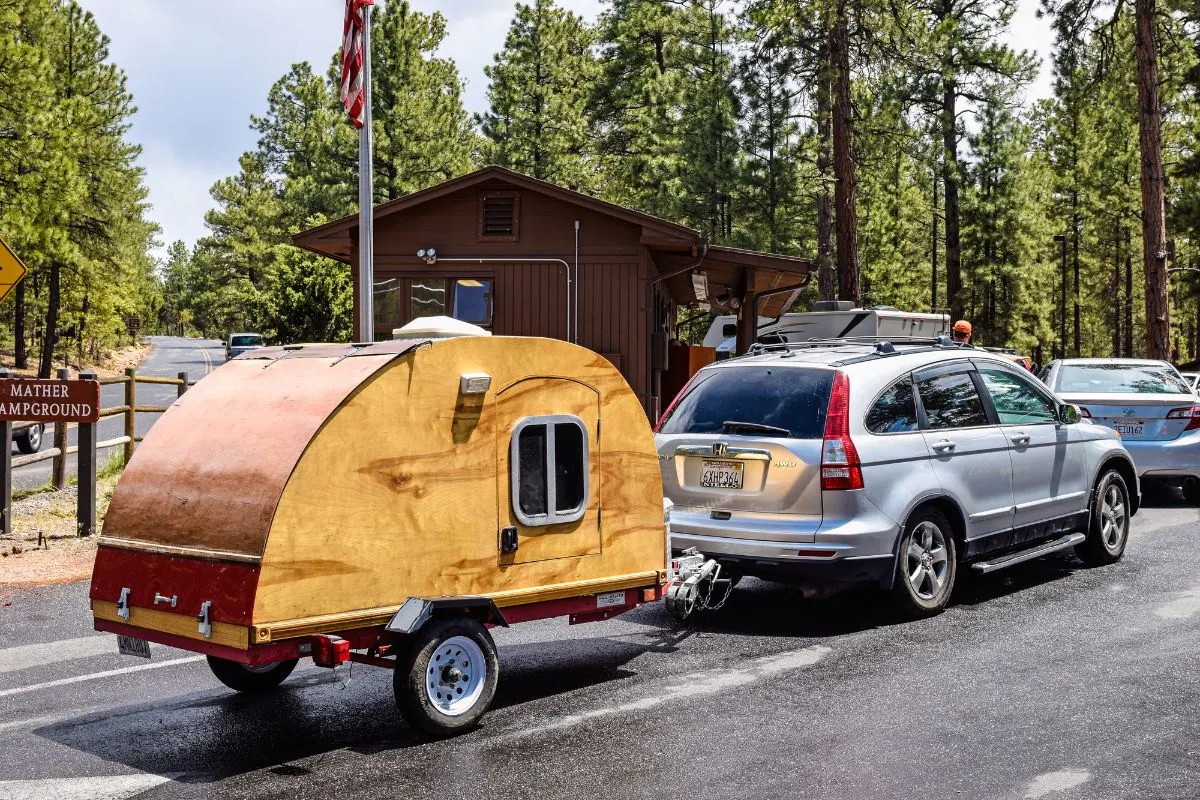
Now we are getting into the smallest of the small part of the list. A teardrop is notable due to it’s sideways teardrop shape. If you saw one, you’d know instantly what you were looking at. Technically, it’s light enough to be towed by a Kia Soul. However, you’d always want to run it by the salesperson before buying a Soul for that specific purpose.
With an RV that tiny, it might be hard to imagine having much breathing room. Looks can be deceiving. There’s storage under the sitting bench. You can take a shower. The TV swivels so you can choose where you want to view from. There’s a dining table that can be converted into a queen bed. Also included is a stove, sink, fridge, closet, and cabinets for food.
Makers of teardrops know that storage could be a problem, so they made sure to have multiple interior and exterior places to stash things. These units typically sleep two comfortably.
5. A-Frame Trailer
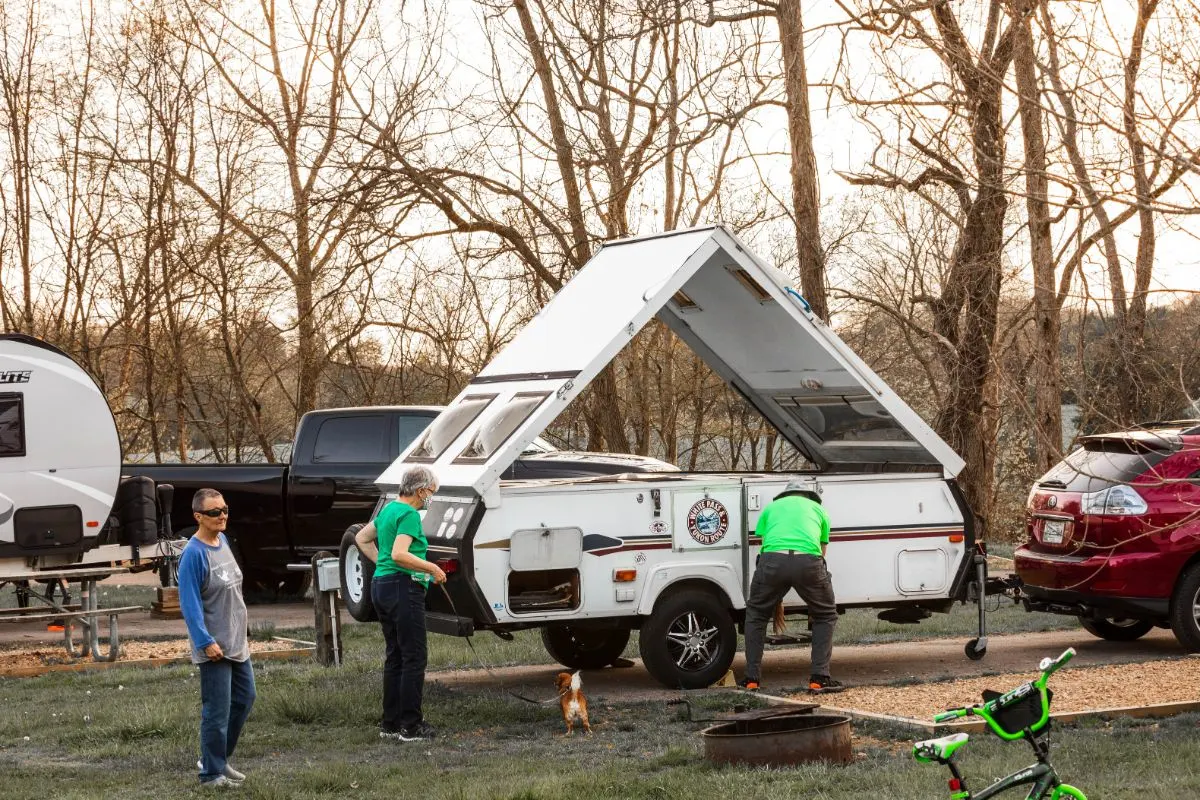
These unique RVs are just as noticeable as the teardrop because of their shape. As the name implies, they are shaped like a giant A. The roof comes to a point. At first glance, you might perceive an a-frame as a tad claustrophobic or hard to enjoy for a tall person.
On the contrary, similar to the pop-ups, a-frames pop out. Once you’re sitting in your parking spot, the windows on the side open up to create extra headroom. You can also see it as a skylight. Either way, it’s a win.
What do you get inside such a compact space? Well, unlike the other tiny units, you could technically sleep three. As impossible as that seems when you look at an a-frame, there’s a sofa bed and the dinette converts into a bed. It may be a squeeze, but isn’t that what campers are all about? There’s also extra storage, a refrigerator, sink, and microwave.
6. Truck Camper
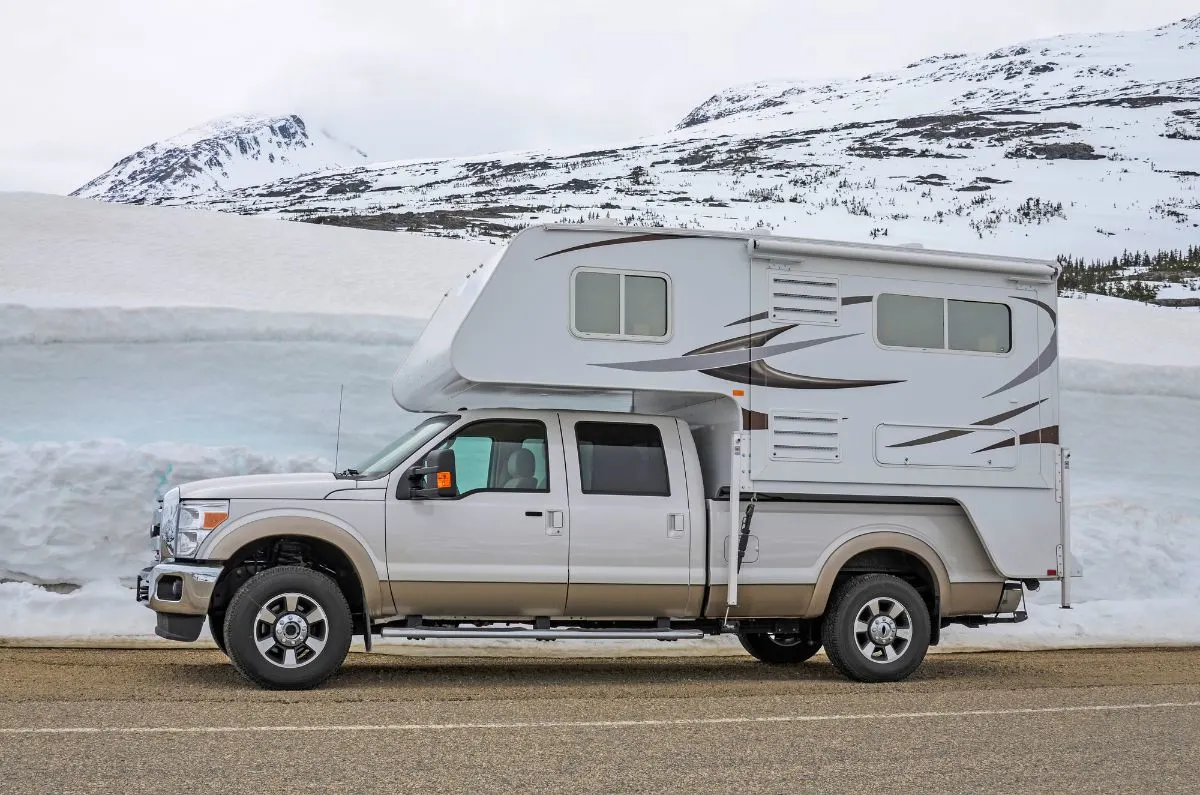
Perhaps the smallest of all is about the space of a truck bed, plus a little extra. This is, as it sounds, an RV that uses a truck to create a living space. The whole process is very automated. When not in use, the truck camper has legs that keep it from tipping over if it is left unattended.
The legs come out wider than the truck. That way, when you’re ready to get going, you will just back the truck under the truck camper. Ready to sit a while? With the press of a few buttons, the legs come up and you can situate the truck camper snuggly in place.
This is not a great option for those who might have difficulty getting up into a truck, since that’s how you’ll get into the RV. Once hoisted inside, the bed is all the way in the back, the back being the space above the truck cab. There’s also a dinette against the wall, cabinet space, a stove, and a mini-fridge.
As you might imagine, unlike the other options, this RV doesn’t plug directly into the water system of a campground. Most truck campers come with the space to have a portable toilet in a cabinet. This isn’t required and might be cumbersome, but some people swear by it.
Truck campers sleep two.
What Are the Best Small RVs for Full-Time Living?
RVs aren’t just for travel anymore.
Okay, now that I’ve given you a solid course on what you should expect from the various small RVs, let’s dig deeper. Whether you have a lot of experience with RVing or you’re new to the concept, the industry is coming out with upgrades every year. So, anyone is able to learn something new.
Technically, all small RVs are capable of full-time living, it just depends on your perspective. Before you look up your local RV dealership and have talks with a salesman, there are some things you should consider. Asking yourself the following questions will help narrow your search and make you an educated purchaser.
- Who is all coming along for the ride?
Are you a parent with children? Is it just you and your significant other? Perhaps this is a solo venture. This question may seem obvious, but often it requires a little mulling over. - What is the objective?
Are you traveling across the continental United States? Are you parking at a local campground? How far you’re going has an impact on what you’re bringing and how much storage you’ll need. - Are you planning for outdoor adventures?
Similar to needing space for long-distance traveling, you will also need space to put in equipment. What type of activities are you interested in? What type of toys are you planning to take? Some places offer rentals, know before you go. - What will be your expected indoor activities?
Will kids need space for class? Does there need to be room to spread out papers and a laptop? Do you like to stretch out and watch TV? Do you have hobbies that need your own platform to do? Thinking about what you’ll be doing inside the RV is as important as where you plan to go with it. - What type of vehicle do you have?
Aside from the Class B, you will need a vehicle to pull your towable. If you have a monster truck, anything is fair game. However, a lot is dependent upon weight.
Alright, now that you’ve had a chance to wrap your mind around the daily RV grind, I will give you a scope for each listed type. All of these can be used by solo travelers, but who else?
1. Class B
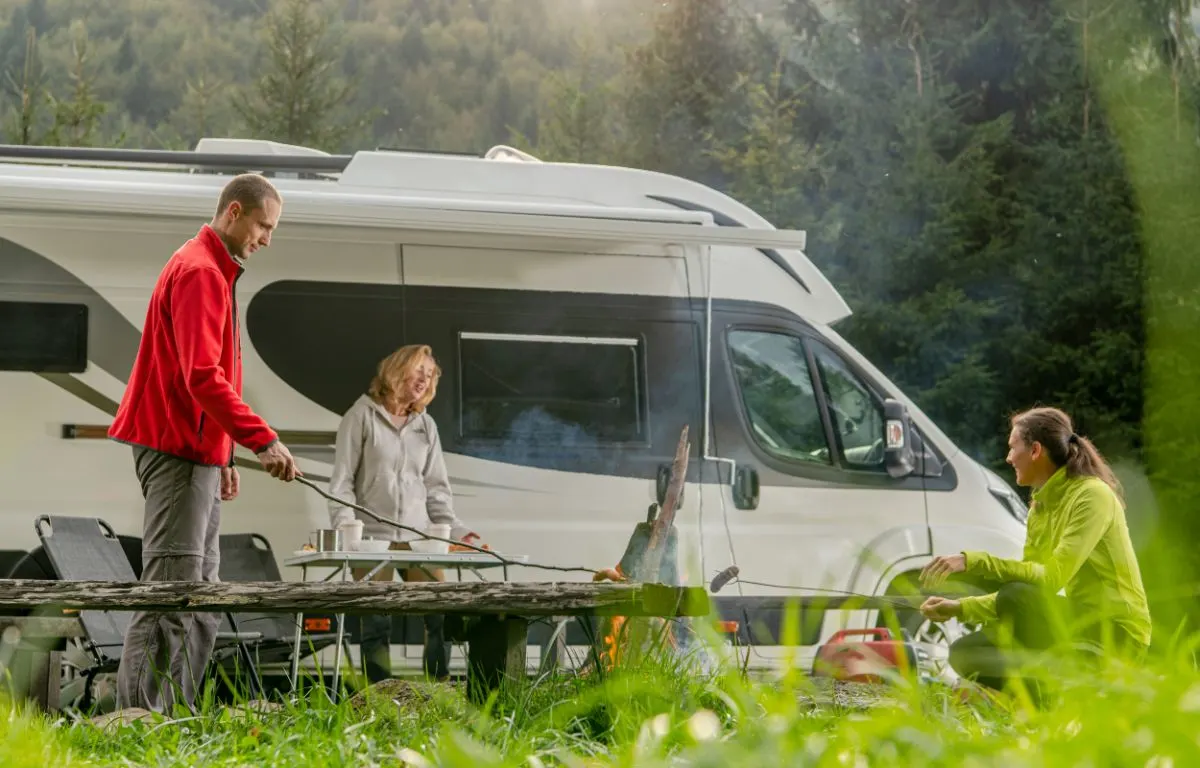
Who is it best for? Couples.
Class Bs are a kind of budget Class As. Even though I talked about how pricey a Class B can be, they still aren’t as expensive as a Class A. All of the newer models are just as luxurious as a Class A but on a smaller scale. So, the couples that get the most out of Class Bs are the retirees who don’t have the ability to pay for a Class A but want the amenities.
These are usually people who are unable to physically get involved with something that needs to be towed. They want something sleek and simple that is ready to hit the road right off the lot. A turnkey RV. That’s why they are willing to pay more for something the size of a Class B, it’s manageable, requires little work, and there is no need to have any other vehicles.
To give you even more of that Class A feel, the front seats are roomy swivel chairs. The interiors are also similar in design, a lot of granite counters and top-quality floors. To appear more spacious, the top opens up to let in natural light like a vaulted ceiling.
I picture grandparents taking the Class B to visit their child’s home that lives a long distance away. They take the RV to avoid having to fly and they can pull over and stay overnight along the way. They can take the grandkids out for a joyride, but not a full vacation.
2. Lightweight Trailer
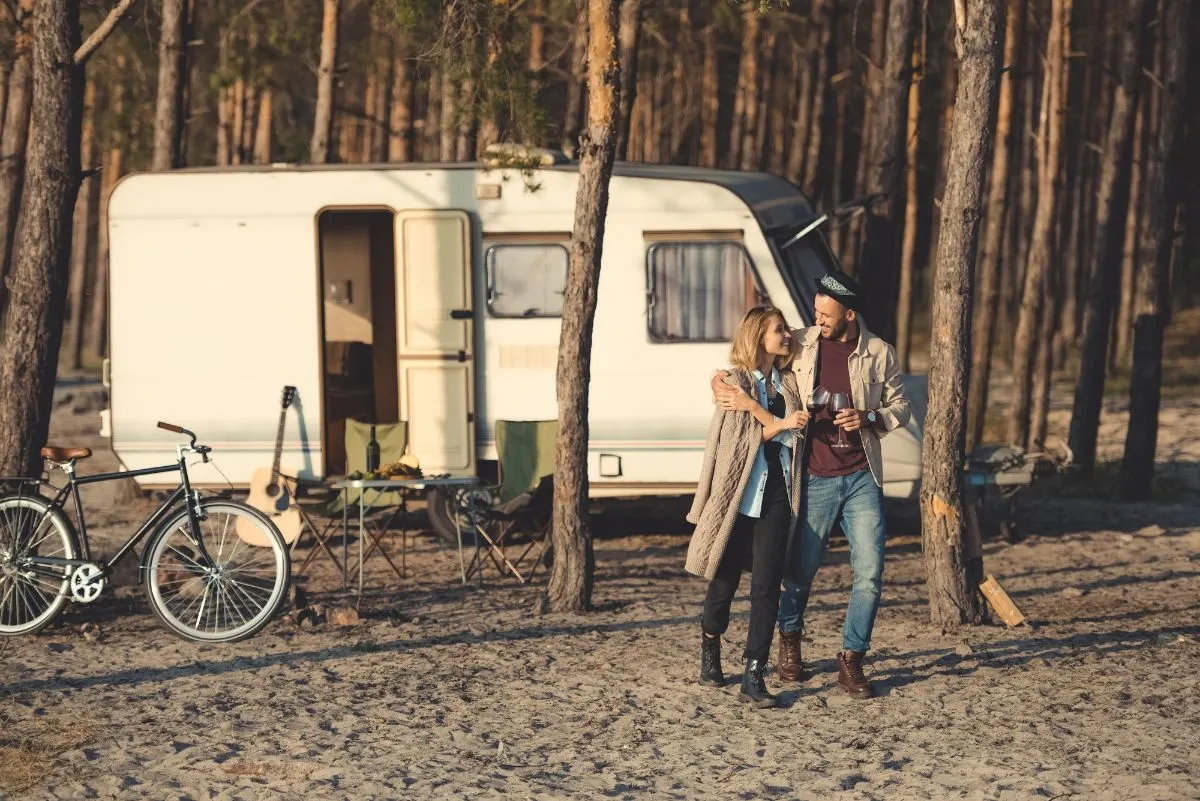
Who is it best for? Couples or families with up to two children.
This is the biggest of the smalls. The lightweight trailer offers a lot of stretching room and stations to separate out individuals. Depending on which floorplan you go with will be the determining factor in how many children to bring. Two is the most comfortable number for sleeping and existing, in general.
Unlike the others on the list, parents could have a private area where they sleep. You can usually find bunkbeds on the opposite side of the RV from the queen bed. There are also dining tables with booths on either side, as opposed to the U-shaped booths. You will want this option if you’re bringing two kids. That way they can have their own seats to do work, projects, or something fun. I would not advise full-timing with two teenagers in a lightweight trailer.
This would also be a great pick for those grandparents from the last example. After only being able to visit, they might want to upgrade the space for the chance to take the kids on an unforgettable summer vacation sans parents. This would be ideal.
3. Pop-up Trailer
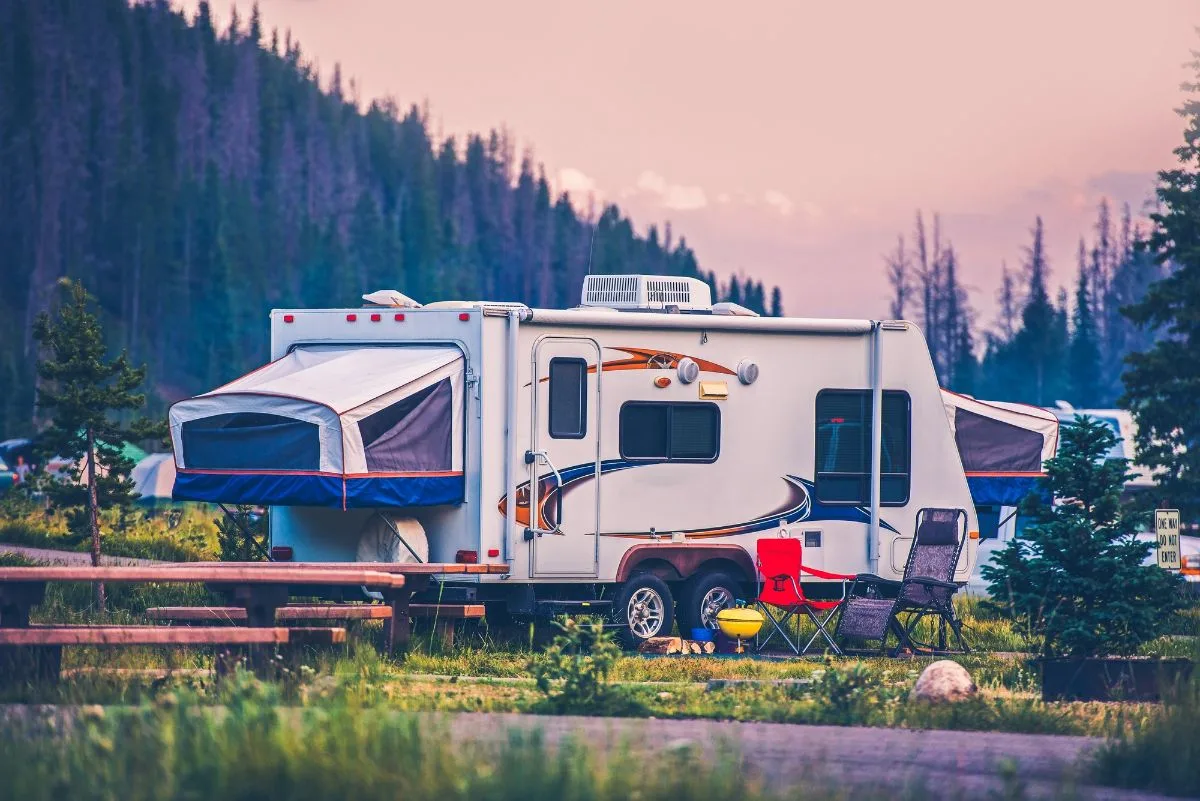
Who is it best for? Couples or families that include a small child.
This is sort of the roughing it equivalent for two adults and one little person, max. Technically, you can sleep more than that, but it’s important to be aware of how much area someone needs for themselves. These are not known as spacious and you want everyone to be comfortable. The booths are similar to other RVs, they pull out for sleep and can be used for storage.
There are quite large pop-ups with what could be viewed as two bedrooms, which is amazing considering how compact they are. For relaxation, there is a couch, but that is about all of the seating area inside of a pop-up, aside from the dining room. That’s why it’s a great space for adults and a child but would quickly become cramped with additional bodies.
4. Teardrop Camper
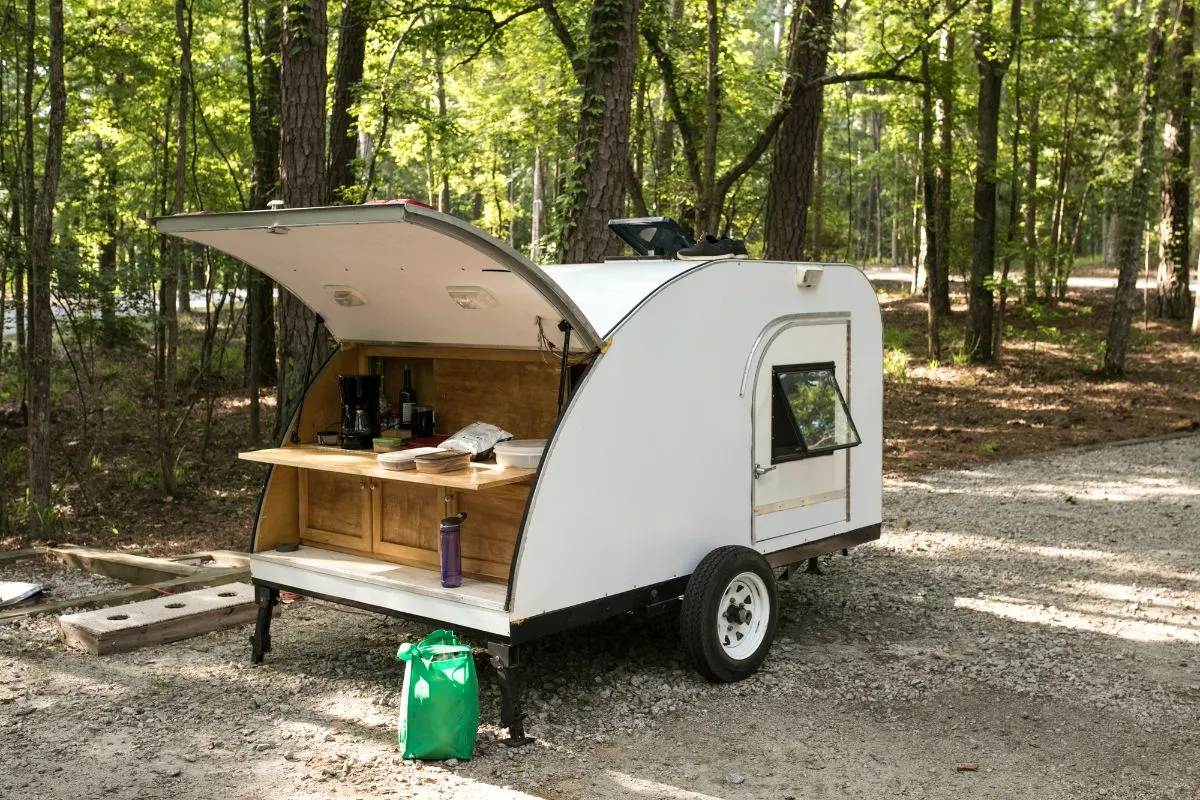
Who is it best for? Couples.
This and the a-frame models are really meant for nice but not luxurious living. The amenities are less but still provide you the essentials. A couple that goes for the teardrop is one that is ready for the type of exploration that will require some manual labor. For one, you have to hitch it to a ride. For two, you will have to hook it up to the water system wherever you stop.
Showering is more of a wet bath scenario by the toilet. That’s something that might be less maneuverable for an older couple, but a younger couple can work around it. You’d also have to set up and take down the bed every day, since it’s a foldout from the dining area.
As limiting as that might sound, remember this type of unit comes with a lot of storage. So, this is great for a couple on the hunt for thrills. There’s room to store equipment inside and outside of the RV. It’s light enough to be pulled by a car, so this could be great for a budget as well.
5. A-Frame Trailer
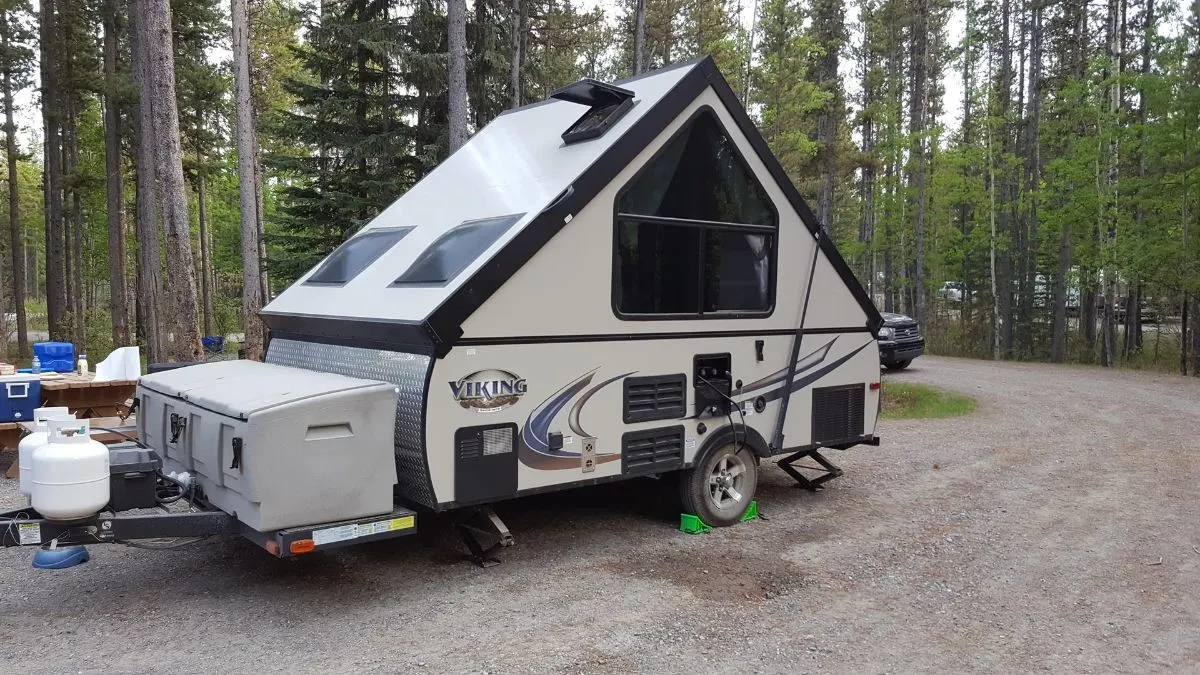
Who is it best for? Couples or families that include a small child
All that’s really inside of an a-frame is a convertible dinette, a few shelves, and a sofabed. So, you have a place for a young child to sleep and the parents. There’s room to store the essentials. Make the outdoors a playground and you really can enjoy living in it for a while.
6. Truck Camper
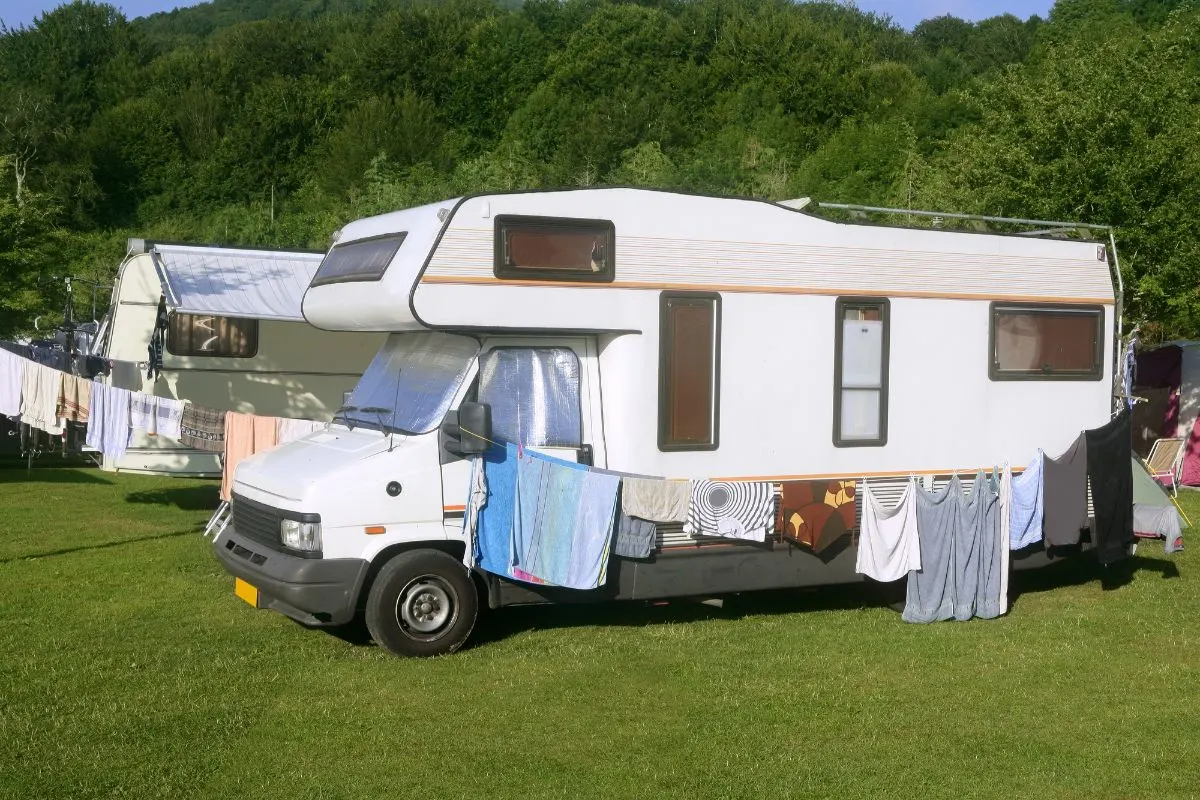
Who is it best for? Solo.
Technically, you can fit a second person, but really the room inside is extremely limited. The seating area is in the dinette and bed. The limited storage makes packing for more than one person a tough one. That’s why this is a thriving option for a solo traveler. The bed would be spacious and the seating room would be extra stretching room for a change of seats.
You’d also have a table big enough for a couple of guests. Just because you’re travelling solo doesn’t mean you won’t make friends at the various campgrounds you settle in. There’s enough room inside to make a dish and share it comfortably. Nothing elaborate, there’s not enough room in the kitchen, but a humble meal can be just as delicious as a fancy one.
Having the table all to yourself the rest of the time is also a massive benefit. You can set up an office or keep the space for a hobby or map collection. Another positive is that whenever you want to run into town, you can put the legs down and drive off. More often than not, RV campgrounds are very safe. There’s also all the extra eyeballs to witness a theft.
